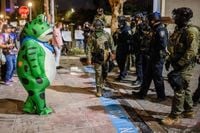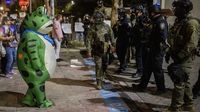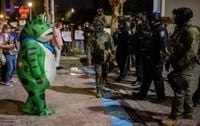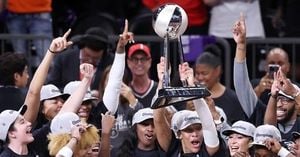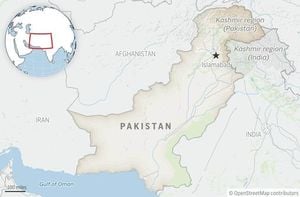The streets of Portland, Oregon, have always been a canvas for protest, but in October 2025, the city’s demonstrations against federal immigration enforcement and the deployment of National Guard troops took a turn that no one saw coming—unless, perhaps, you were looking for a frog, a chicken, or even a unicorn. As President Donald Trump sent more than 200 National Guard troops to Portland, aiming to quell what he called “premeditated anarchy,” local residents responded not with violence, but with a colorful spectacle of inflatable costumes, sharp wit, and a dose of absurdist humor.
It all began to catch fire on October 2, when Seth Todd, a protester dressed in an inflatable frog costume, joined a crowd outside the Immigration and Customs Enforcement (ICE) detention center. According to Le Monde, Todd’s intention was clear: “It is a strategy to cut the narratives of the Trump administration, which says we are extremely violent. No, we are protesting, but with humor.” Todd, who has since become known as the “Portland Frog,” found himself at the center of a viral moment when police fired tear gas directly into the vent of his costume as he tried to help fellow activists targeted by law enforcement. The image of a costumed frog coughing through a haze of gas quickly spread across social media platforms, turning Todd into an unlikely symbol of nonviolent defiance.
But the frog was not alone. As reported by CNN and Willamette Week, other demonstrators took up the cause with inflatable chicken, unicorn, peacock, dinosaur, and raccoon suits. Jack Dickinson, known locally as the “Portland Chicken,” described the effect of these costumes: “It becomes much harder to take them seriously when they have to post a video saying Kristi Noem is up on the balcony staring over the Antifa Army and it’s, like, eight journalists and five protesters and one of them is in a chicken suit.” Dickinson first donned his costume during Trump’s military parade in June, aiming to counter “the show of force with farce.”
The costumed antics were more than just a punchline. As NBC News observed, the inflatable suits served a practical purpose as well, providing a layer of protection against tear gas and other toxins deployed by federal agents. Brooks Brown, a protester from Vancouver, Washington, took the effort further by launching “Operation Inflation”—a campaign to distribute dozens of inflatable costumes to anyone willing to join the spectacle. “If you’re going to make it silly and say that we’re evil, we’re going to make it silly by showing how evil you are,” Brown explained, passing out costumes to create what he called a “night circus” outside the ICE facility.
The protests, which erupted after Trump’s deployment of the National Guard, have been characterized by the White House as a “reign of terror” led by radical leftists. In a statement, the administration argued, “While Democrat politicians deny reality, it’s obvious what’s happening in Portland isn’t protest; it’s premeditated anarchy that has scarred the city for years − leaving officers battered, citizens terrorized and property defaced.” Federal officials doubled down during a federal appeals court hearing on October 9, with Department of Justice attorney Eric McArthur labeling protesters as “violent people” who hurled rocks and set fires. They pointed to the three-week closure of the ICE building from mid-June to early July, citing damage allegedly caused by demonstrators.
Yet, on the ground, the reality appeared far less dire. According to The New York Times and Oregon Public Broadcasting, local photographers and reporters documented scenes of everyday life continuing undisturbed—people sunbathing, ordering coffee, and strolling through parks—contradicting the administration’s claims of a city in chaos. Rachel Smolkin, CEO of OPB, emphasized, “Our OPB team is reporting the facts on the ground as they unfold with as much context as we can offer. When the facts diverge from statements about the city, we note the discrepancies. Video and photos are powerful reporting tools in this type of news coverage.”
Local and state officials were quick to push back against federal intervention. On October 4 and 5, federal Judge Karin Immergut issued rulings blocking President Trump’s order to send in troops, at least until October 18. Portland’s mayor, Keith Wilson, declared, “This is an American city. We do not need any intervention. This is not a military target. The president will not find lawlessness or violence here.” Senior Assistant Oregon Attorney General Stacy Chaffin echoed this sentiment before a panel of federal judges, describing the administration’s portrayal of Portland as “untethered from reality.”
Even amid the spectacle, Portland’s civic challenges remained. The city, with a homeless population of around 7,000, saw an 8% increase in simple assaults compared to the previous year, according to police and city data. However, homicides dropped by 50% and aggravated assaults by 4%, with overall crime rates holding steady. These statistics, cited by NBC News, further undermined the narrative of a city spiraling out of control.
Satirical responses to the “war zone” rhetoric spread beyond Portland. California Governor Gavin Newsom joined in, posting a video on X (formerly Twitter) of a unicorn, raccoon, and dinosaur dancing outside the immigration building, captioned, “Portland is war ravaged! SEND IN THE CALIFORNIA (???) NATIONAL GUARD!” Illinois Governor JB Pritzker, meanwhile, appeared in a spoof video on Jimmy Kimmel Live!, donning body armor and joking about the horrors of Chicagoans being forced to eat hot dogs with ketchup.
Not everyone was amused. Conservative journalist Andy Ngo argued that the costumes served to “mask the violent extremism to make the direct action appear like a family-friendly gathering on camera, and to whitewash the past ultraviolence.” The information war, as one local TV reporter-turned-MAGA poster put it to NBC, was in full swing: “This is now a full-blown information war that we’re in, so being on the front lines is more important than ever…” In this bifurcated media world, one side’s comparative calm is the other’s “hellscape.”
For many Portlanders, however, the inflatable costumes have become a symbol of resilience and creativity in the face of state power. Joy Wilson, a local resident, attended her first protest in costume after witnessing federal agents pepper spray Todd in his frog suit. “People should be able to protest. They should have their voices heard,” she said, reflecting the spirit of peaceful resistance that has come to define the city’s response. Her husband, Kevin, and their teenage daughter joined in, handing out pizza and picking out new costumes for future demonstrations. “Should I go with the unicorn?” Kevin mused, eyeing a selection that included a lobster, shark, and bear.
As the dust settles and the court battles continue, Portland’s frog, chicken, and unicorn brigade stand as a testament to the city’s enduring belief in protest, humor, and the power of a good costume to challenge authority. For now, at least, the message from Portland is clear: when confronted with force, sometimes the best response is a little bit of farce.
